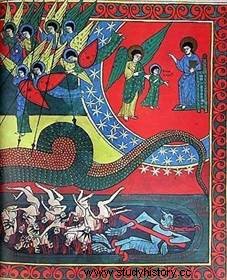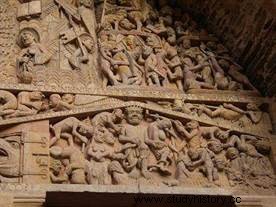 The life of chronicler Raoul Glaber (Rodulfus Glaber dit le Chauve), a Burgundian monk born at the end of the 10th century, remains little known. His name and personality are nonetheless a subject of controversy among historians. Associated by romantic historiography and by Michelet with the so-called "terrors of the Year One Thousand", he was also presented as a jovial and undisciplined monk but also as a fine scholar, author of poetry and theologian, very attached to the reform monasticism of which Cluny wants to be the spearhead.
The life of chronicler Raoul Glaber (Rodulfus Glaber dit le Chauve), a Burgundian monk born at the end of the 10th century, remains little known. His name and personality are nonetheless a subject of controversy among historians. Associated by romantic historiography and by Michelet with the so-called "terrors of the Year One Thousand", he was also presented as a jovial and undisciplined monk but also as a fine scholar, author of poetry and theologian, very attached to the reform monasticism of which Cluny wants to be the spearhead.
Raoul Glaber, an eventful life
Probably the illegitimate child of a cleric or a monk, placed as an oblate in the priory of Saint Léger de Champeaux, his life is the site of chronic instability. Raoul Galber himself does not present himself as a model monk and he does not seek to be one. Little diligent, renowned for his outspokenness and for standing up to his superiors, he was regularly expelled from monasteries. He resides in particular in Saint Germain d'Auxerre where he receives a solid training, in Moutier-en-Puisaye but especially in Cluny. However, he made an important meeting with the Abbot of Saint-Bénigne de Dijon:the reformer Guillaume de Volpiano, a disciple of Maïeul de Cluny and who took him under his protection.
It may seem paradoxical that this very austere and pious character always protected Raoul Glaber, whose misconduct was notorious. However, Guillaume de Volpiano tended to protect monks who knew how to write, he was looking for talented monks in literary and artistic creation as well as to carry out this monastic reform to which the Glabre is attached. Indeed, he follows him throughout his travels, including Italy, and retires to the monastery of Cluny following the death of his mentor, of whom he wrote his Life but also to write your Stories in five books which he completed shortly before his death in 1047 at the Abbey of Saint-Germain d'Auxerre.
The historian of the year 1000
 Raoul Glaber is remembered mainly for one of his sentences:"It was as if the world itself was shaken and, stripping off its obsolescence, put on everywhere a white church robe" (according to the French translation by the historian Georges Duby), it is therefore very often to this monk that the we refer to when we talk about the "white mantle of the church" covering the world or France.
Raoul Glaber is remembered mainly for one of his sentences:"It was as if the world itself was shaken and, stripping off its obsolescence, put on everywhere a white church robe" (according to the French translation by the historian Georges Duby), it is therefore very often to this monk that the we refer to when we talk about the "white mantle of the church" covering the world or France.
Nevertheless, for historians, it is above all one of the most important written sources of the 11th century. As such, his Historiæ are a scholarly work, reflecting the quality of the Cluniac school of that time. Following an introduction based on cosmology and the order of the world, Raoul Glaber describes and analyzes the changes that occurred in the West from the year 900 to the year 1044, passing above all through the year 1033 (millennium of the Passion of Christ ) which gave birth to the mythical terrors of the year 1000 taken up in particular by romantic historiography. He sometimes passes for a millenarian monk reporting natural disasters, climatic disturbances and famines announcing the end of the world.
However, we must realize that our chronicler monk makes heavy use of testimonies to write and that he is particularly credulous and talkative, sometimes recounting his encounters with the Devil:"A night stands before me a kind of terrible monster to see. Small in stature, he had a slender neck, a thin face, very black eyes, a rough and wrinkled forehead, pinched nostrils, an enormous mouth, swollen lips, receding chin, a goatee's beard, hairy ears and pointy hair, spiky hair and dog teeth, flattened skull, swollen chest, humped back”.
It is therefore appropriate to put aside the superstitious Glabre in order to obtain a real document on the mentalities of the 11th century, containing a wealth of historical facts and events, but also to understand that this book is much more than a simple collection of testimonies.
Raoul Glaber at the service of Cluniac reform
The Study of Stories by Raoul Glaber is revealing of the erudition of this reputed troublemaker monk but also of his attachment to the monastic reform carried out by the Abbey of Cluny. Here are two examples, particularly characteristic of his work.
 The Prologue of Stories of the chronicling monk includes, among other things, a strong influence of Platonism which serves as its foundation. Indeed, Glaber went through the Saint Germain d'Auxerre abbey where in the 9th century the Irish monk, Scot Erigene, had passed, a great intellectual sometimes on the verge of heresy, dealing with Greek cosmology, who by translation of the works of a Greek theologian of the High Middle Ages is brought into contact with the philosophy of Plato and more particularly his Timaeus . The influence of Neoplatonists like Iamblichus or Proclus also appears in the work of the monk.
The Prologue of Stories of the chronicling monk includes, among other things, a strong influence of Platonism which serves as its foundation. Indeed, Glaber went through the Saint Germain d'Auxerre abbey where in the 9th century the Irish monk, Scot Erigene, had passed, a great intellectual sometimes on the verge of heresy, dealing with Greek cosmology, who by translation of the works of a Greek theologian of the High Middle Ages is brought into contact with the philosophy of Plato and more particularly his Timaeus . The influence of Neoplatonists like Iamblichus or Proclus also appears in the work of the monk.
This presence of Greek philosophy may surprise, but it is not contradictory with monastic thought, which gives it a precise interpretation. Indeed, if the term "philosopher", etymologically speaking, designates those who love wisdom, philosophy being the love of wisdom, the monks of Cluny understand it as a morality. The philosopher is not the scientist but the holder of moral wisdom, knowing what God wants. The Stories by Raoul Glaber thus appear deeper than at first glance, they offer a real testimony to the Christian monastic thought of the 11th century, a thought largely inherited from Greek philosophy as well as ancient cosmology.
If, moreover, the will of the Cluniac chronicler is to write the history of the whole cosmos, it is also because his conception of medieval society and the cosmos comes from a musical conception characteristic of the monastic reform. For Raoul Glaber, music is at the top of the hierarchy of the seven liberal arts taught in monasteries and schools (these are grammar, dialectics, rhetoric, arithmetic, music, geometry and astronomy). Music expresses the perfect harmony of all things, the perfection of God, a perfection which is also found in the monastic liturgy. So his Stories have a real liturgical dimension and become a gift of prayer, the primary activity of any Cluniac monk.
Raoul Glaber was not only a witness and historian of his time, he also fulfilled his mission as a monk, performing his liturgical office through his work and carrying the ideas advocated by the Cluniac reform.
Bibliography
- Georges Duby's year one thousand. Folio History, 1993.
- Grandeur de l'an mille by Pierre Riché. Bartillat, 2008.
- Chronicle of the year one thousand by Raoul Glaber. Paleo, 2000.
